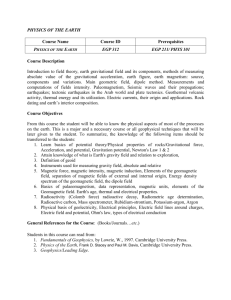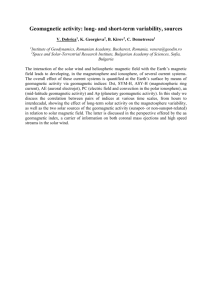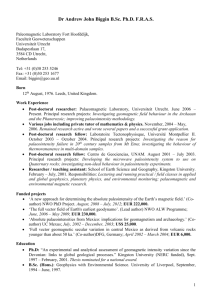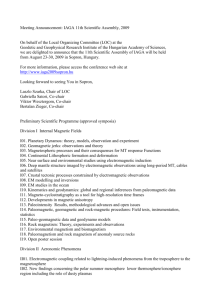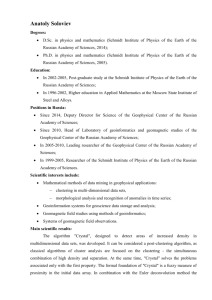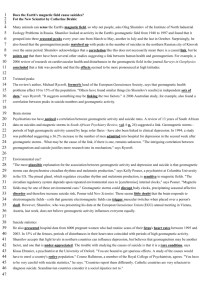Geomagnetic field variations in the southern African region and its
advertisement
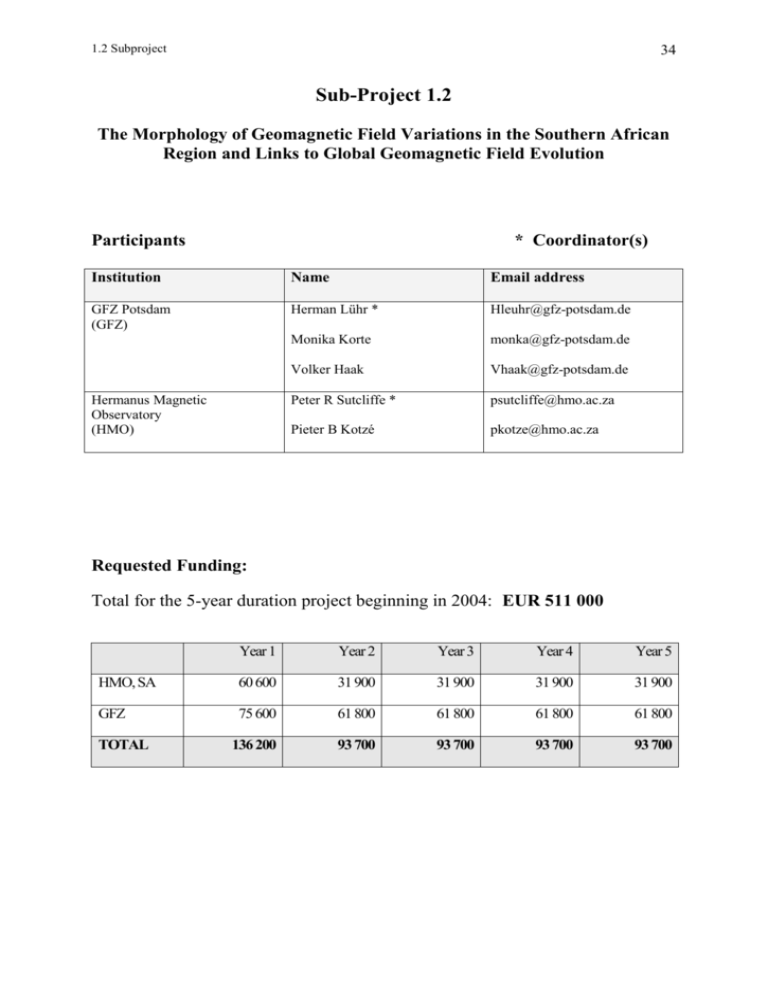
1.2 Subproject 34 Sub-Project 1.2 The Morphology of Geomagnetic Field Variations in the Southern African Region and Links to Global Geomagnetic Field Evolution Participants * Coordinator(s) Institution Name Email address GFZ Potsdam (GFZ) Herman Lühr * Hleuhr@gfz-potsdam.de Monika Korte monka@gfz-potsdam.de Volker Haak Vhaak@gfz-potsdam.de Peter R Sutcliffe * psutcliffe@hmo.ac.za Pieter B Kotzé pkotze@hmo.ac.za Hermanus Magnetic Observatory (HMO) Requested Funding: Total for the 5-year duration project beginning in 2004: EUR 511 000 Year 1 Year 2 Year 3 Year 4 Year 5 HMO, SA 60 600 31 900 31 900 31 900 31 900 GFZ 75 600 61 800 61 800 61 800 61 800 136 200 93 700 93 700 93 700 93 700 TOTAL 1.2 Subproject 35 Summary The existence of the geomagnetic field has numerous important benefits for society; for example, two such benefits are its shielding against the damaging radiation from space and its implementation in navigation systems. Presently, the magnetic field of the Earth is declining at a phenomenal rate. At the current rate of decline, the dipole field will vanish within about a millennium, which is ten times faster than the natural decay after a complete switch-off of the geodynamo. The rapidly decreasing field has evoked the suggestion that a reversal of the geomagnetic field may have already commenced. Important indicators about the field variations can be found in the detailed structure of the magnetic field at the core/mantle boundary. There have been two prominent patches of reverse magnetic polarity identified which can account for almost all the present day decrease. The most intense reverse patch is beneath the southern tip of Africa. A detailed study of the geomagnetic field in this key region, supported by the global monitoring of the magnetic field from satellites like CHAMP, will help to better explain and predict the secular variation on a larger scale. The southern African subcontinent is therefore an ideal location for studying the processes responsible for both the regional and global changes of the geomagnetic field. This will facilitate a better understanding of field behaviour, the coupling to other geophysical processes, and the implications for society. 1.2 Subproject 36 Scientific Motivation Rapid Decrease of the Field Intensity Since the start of systematic magnetic field recordings, some hundred years ago, a continuous decrease of the Earth’s magnetic dipole moment has been observed. The change in the field strength is, however, not evenly distributed over the globe. At the Earth’s surface the most rapid decrease of the main field is observed in the Atlantic region. Southern Africa is in this regard the continental area where these geomagnetic field changes can be best studied. Since the establishment of the Hermanus Magnetic Observatory (HMO) in South Africa in 1941, the total field intensity has decreased by 20%, which is greater than the decrease at any other magnetic observatory. Presently, the HMO operates three geomagnetic observatories in southern Africa [see section 7: Current Infrastructure]. Figure 1 shows the changes in field strength as recorded by the three observatories. Although all the curves show a declining trend, neither the rate of change nor its temporal variation is identical at the three sites. There are obviously significant gradients in the field decline across the country, which are smaller in scale than the separation of the recording sites. Part of this project will thus be to investigate the temporal and spatial structure of the rapid field decrease below southern Africa with an improved set of observatories. Total Intensity 1941 - 2002 Mean annual values in nanoteslas 32700 32200 31700 31200 30700 30200 29700 29200 28700 28200 27700 27200 26700 26200 Tsumeb Hartebeesthoek Hermanus 25700 1940 1944 1948 1952 1956 1960 1964 1968 1972 1976 1980 1984 1988 1992 1996 2000 2004 Figure 1: Decrease of the geomagnetic intensity at Hermanus, Hartebeesthoek, and Tsumeb 1.2 Subproject 37 Reorientation of the Geomagnetic Field Besides the field intensity, the orientation of the geomagnetic field in southern Africa is also changing rapidly [Kotzé, 2003]. In the northwest part of southern Africa the declination of the magnetic field is propagating eastward (Tsumeb) and in the south-east part westward (Hermanus and Hartebeesthoek), as shown in Figure 2. This causes a spatial gradient over the subcontinent which is presently increasing with time. A greater density of observation points is required in order to resolve the structure of the field orientation and its evolution. Magnetic Declination 1941 - 2002 60 0 -60 -120 -180 -240 Decl : TSU Decl : HER / HBK Mean annual values in min of arc 100 90 Tsumeb. D = -12° + decl 80 Hartebeesthoek. D = -16° + decl 70 Hermanus. D = -22° 48' + decl 60 9.3 '/year 50 11.7 '/year 40 30 20 10 -3.3 '/year 6.3 '/year 0 -10 -20 -30 -40 -50 -2.7 '/year -60 5.0 '/year -70 -80 -90 1940 1944 1948 1952 1956 1960 1964 1968 1972 1976 1980 1984 1988 1992 1996 2000 2004 -300 -360 -420 -480 Figure 2: Evolution of the geomagnetic declination at Hermanus, Hartebeesthoek and Tsumeb. A general picture of the behaviour of the magnetic field components during the past few decades can be obtained from global magnetic field models. As an example, we have used the Comprehensive Model (CM3) proposed by Sabaka et al. (2002). Figure 3 shows how the intensities of the northward (X), eastward (Y) and downward (Z) components have changed over the past 35 years. Curves have been plotted for each degree of latitude along a profile from Hermanus (HER) to Tsumeb (TSU). The model predicts a field decrease in all three components. It is, however, interesting to note that the predicted spatial gradient along the chosen profile is continuously increasing for both the Y and Z components. The rather dynamic variation of the magnetic field in this region requires investigation by a denser array of suitable ground-based observations. 1.2 Subproject 38 Figure 3: Prediction of the magnetic field evolution according to the CM3 model (Sabaka et al., 2002) along a profile from HER (black line) to TSU (orange line) in steps of 1° latitude. Presently, the geomagnetic field is monitored from space by a fleet of dedicated satellites, Ørsted, CHAMP and SAC-C. From their measurements global models of the magnetic field can be derived with an unprecedented accuracy. The secular variation at decadal scale or longer, however, cannot be well determined due to the fairly short lifetime of these missions. An important question, therefore, is how well do secular changes derived from satellite models fit the ground-based measurements in this very dynamic region? If differences are observed, how can they be explained? Are they due to imperfections in the model? Do induction anomalies in the ground adversely affect the model? The existence of such an effect has repeatedly been advocated in the literature (Porstendorfer et al., 1979; Alldredge, 1983), but so far no convincing observations have been presented. This region with its rapidly changing internal magnetic field is ideally suited to test the idea that rapid secular variations can induce currents in highly conductive lateral structures in the lithosphere or upper mantle. The magnetic signature caused by these confined currents is expected to change at the rate of the secular variation and not of the field itself. From the results obtained in such an investigation, it will be possible to decide whether similar studies in other parts of the world can be expected to be successful. Improved Modeling of Core Flow Dynamics The rapid variation of the geomagnetic field is a manifestation of the dynamics of the flow in the Earth’s outer core. In recent geodynamo models, suggestions have been made about the kinds of flow required to support sustaining planetary magnetic fields (Gubbins and Roberts, 1987; Glatzmaier and Roberts, 1995). The continuous decrease of the magnetic dipole moment and the simultaneous increase of multi-pole moments suggest the possibility of an upcoming reversal of the geomagnetic field (Constable, 1992). It is premature to conclude that the present-day downward trend of the dipole field will continue until it has disappeared, particularly as paleomagnetic studies show repeated excursions without a reversal of polarity 1.2 Subproject 39 (Nowaczyk and Frederichs, 1999). However, some indications that a reversal may have commenced, have been presented by Hulot et al. (2002). According to their studies, the asymmetric state of the geodynamo, which produces large longitudinal differences in field changes (cf. Fig. 4), is one through which it has to go before the reversal. Figure 4: Percentage change of the geomagnetic field from 1980 to 2001, as determined by the satellites Magsat and CHAMP. Observations of the long-term geomagnetic field changes, called the secular variation, are one of the few means to estimate the material flows at the core/mantle boundary (Le Huy et al., 2000). In particular, the radial field component and its temporal variation are of particular interest for this purpose. Recent studies have identified distinct patches of reversed magnetic flux at the poles and below Africa which can account for about 90% of the present day field decrease (Hulot et al., 2002). The most prominent feature in this respect is the growing patch of reverse magnetic polarity beneath South Africa. To give an indication of the recent changes, Figure 5 shows the distribution and evolution of the radial magnetic field component at the core/mantle boundary during the past century. The model used here, Jackson et al. (2000), shows a region of declining radial field component (blue area) which propagates north-eastward. At present this patch is just below South Africa. By closely monitoring the magnetic field changes in the southern part of Africa, we have the opportunity to track this patch and record its evolution. An objective is to use dedicated measurements for constructing detailed models of the core flow in this region, which seems to play a key role in the presently observed magnetic field decline. Only through a better understanding of the dynamic processes taking place in the Earth’s liquid core, do we stand a chance of improving our ability to predict changes of the geomagnetic field. 1.2 Subproject 40 Figure 5: Secular variation of the radial magnetic field component at the core/mantle boundary for the epochs 1900, 1930 (top) and 1975 and 1990 (bottom) using the model of Jackson et al. (2000). Blue colour marks areas with diminishing field intensity. Extreme values are ±13 μT/a. Deepening of the South Atlantic Anomaly Comparisons of Magsat and CHAMP satellite data indicate that the relative decrease of the geomagnetic field is particularly strong in the Atlantic and American sector (cf. Fig. 5). This coincides partly with the South Atlantic Anomaly (SAA), a vaguely-defined, oval-shaped geographic region centred to the east of Brazil, where the geomagnetic field is significantly weaker than over the rest of the Earth at equivalent altitudes. It is in this region that the shielding effect of the magnetic field is severely reduced, thus allowing high energy particles of the hard radiation belt to penetrate deep into the upper atmosphere to altitudes below 100 km. The hazards of this region appear to lack recognition outside the space science community, although most spacecraft crossing this region at altitudes below 1000 km have experienced damage or degradation to some extent [Heitzler et al., 2002]. 1.2 Subproject 41 Figure 6: Contours of constant magnetic field intensity at 1338 km altitude. Indicated are sites of spacecraft anomalies, TOPEX (yellow dots) and recent MODIS failure (star) (by courtesy of J.R. Heirtzler, NASA/GSFC). The continuing, observed weakening of the magnetic field will result in the expansion of the hazardous SAA region as well as a shift towards southern Africa. The reliable determination and evaluation of the radiation hazard in this region is of utmost importance to space agencies and other institutions operating satellites in low-Earth orbit, particularly for the assessment of radiation risk to humans in space. The planning of satellite missions and the development of space-borne experiments and infrastructure call for predictions of space environment conditions about a decade in advance. Estimates of field changes have to be based on the interpretation of processes taking place in the Earth’s outer core; consequently, results obtained in the previous section will be required to predict the evolution of the SAA. Scientific Goals and Societal Benefits Better Quality Geomagnetic Field Models One of the immediate practical benefits of this project is that it will enable the HMO to develop better quality geomagnetic field models for the southern African region (i.e. South Africa, Namibia, Botswana, Mozambique, and Zimbabwe). This will be of benefit to a number of non-research organisations and individuals. For example, the Chief Directorate Surveys and Mapping provides geomagnetic declination information on all maps which they publish and distribute. The Directorate for Geospatial Information of the South African National Defence Force and the South African Civil Aviation Authority utilise geomagnetic declination information in the maintenance of air traffic safety. In addition, the data will be incorporated into the construction of an International Geomagnetic Reference Field (IGRF) 1.2 Subproject 42 model [e.g., Mandea and Macmillan, 2000] generated under the auspices of the International Association of Geomagnetism and Aeronomy (IAGA). This study is expected to provide improved projections of the evolution of the magnetic field five years ahead, information which is incorporated in the IGRF model. Verification of Satellite Derived Geomagnetic Field Models by Ground Observations The high quality data from CHAMP have enabled GFZ to generate geomagnetic main field and secular variation models of much higher resolution than were previously possible. The extension of the models to shorter wavelength (about 500 km) requires for its verification a spatial density of ground-based observations which is not supported by the present network of magnetic observatories. This proposed project will enable a detailed verification of satellite derived geomagnetic field models from ground observations in this interesting region, besides the European and north American continents. The continuous measurements will furthermore serve as a check of the external magnetic field corrections used in the field separation procedures. Scientific Capacity Building and Training The technical implementation of the project and much of the research will be carried out in South Africa; however, South African technical staff responsible for data processing have very little experience of satellite data processing. The GFZ, on the other hand, has developed significant knowledge and expertise in the management and processing of geomagnetic field data from the CHAMP satellite mission. Inexperienced HMO technical staff will be sent to GFZ for training and to gain experience in the processing of satellite data. It is also clear from the scientific motivation that this proposal will lead to numerous research opportunities and interest by the international research community. Research associated with the project that is carried out in South Africa will thus be used for the training of students. Improved understanding and monitoring of the SAA radiation hazard The deepening SAA could become a major radiation hazard in the future, especially for low Earth orbiting (LEO) satellites. This project will facilitate contributions to the prediction of the radiation hazard for satellites in operation and for spacecraft crews. Implementation and Work Schedule 1.2 Subproject 43 Establish an Additional INTERMAGNET Quality Geomagnetic Observatory Two of the three geomagnetic observing stations which the HMO currently operates in southern Africa, namely Hermanus (HER) and Hartebeesthoek (HBK), are INTERMAGNET quality stations. However, the third station, namely Tsumeb (TSU) in northern Namibia, does not qualify as an INTERMAGNET quality station. The prime reasons for this are the poor communications link from Tsumeb and the unavailability of dedicated and well trained technical staff. When secular variation field surveys are carried out, the data from the nearest observatory are used to correct for disturbance effects from external sources and to refer the field station data to a common epoch. It is proposed to establish an additional INTERMAGNET-grade observatory between Hermanus and Tsumeb for the following reasons: If it is assumed that an observatory within a distance of 600 km from a secular variation field station provides an acceptable reference for these corrections [as indicated by the circles drawn around the observatories in Figure 1], then it is seen that a large area in the Northern Cape and southern Namibia is not adequately covered. Sufficient coverage could be achieved by locating an observatory somewhere in the Northern Cape or southern Namibia. The declination secular variations at the south-eastern and north-western extremes of southern Africa are currently 10 arc minutes per annum westward and 10 arc minutes per annum eastward respectively. An observatory located between HER and TSU would help to accurately monitor the spatial change of secular variation across southern Africa. A site that appears to be suitable for locating an observatory has been identified in southern Namibia. It is located at Gamsberg [23o 16’ S, 16o 30’ E], the site of the HESS gamma ray telescope. It would cover most of the presently uncovered region and is located near the southern end of the region covered by Tsumeb. It is probably geologically suitable, but may suffer induction effects from the Damara conductive belt to the north. There are likely to be excellent infrastructure and technical assistance available. Increase HMO’s Network of Secular Variation Field Stations The HMO currently has a network of 10 secular variation field stations distributed over southern Africa (4 in South Africa, 3 in Namibia, 1 in Botswana, and 2 in Zimbabwe) which are visited once per year [indicated by the blue dots in Figure 1]. Recent experience has shown that this number of stations is insufficient to accurately model the secular variation due to the increasing temporal and spatial gradients. It is proposed that the number of secular variation field stations be increased to about 40 and that half of these be visited in alternate years. The present international quality standards [Newitt et al., 1996] as practised during the southern African repeat station field surveys will also incorporate methods and techniques as described by Korte and Fredow (2001). Collaborative Studies of CHAMP Satellite and Ground Based Data A number of collaborative studies utilizing CHAMP satellite and ground based data are proposed. These studies will also provide suitable research topics for MSc, PhD, and postdoctoral candidates. Some of the potential research topics are: 1.2 Subproject 44 Geomagnetic field modelling, particularly the comparison of satellite-derived and groundbased tested secular variation models Studies of the rapid dipole field decrease and rapidly changing geomagnetic declination Modelling of magnetic fields at the core-mantle interface Studies of the deepening South Atlantic anomaly Training of South African HMO Data Processing Staff at GFZ It is proposed that exchange visits of young staff members be made between GFZ and HMO. For example, visits by German post-doctoral candidates will assist with the training of graduate students and visits by South Africans will enable them to gain experience. Technical staff appointed for the management and processing of data from the magnetometer experiment on board the SASciSat satellite mission will be sent to GFZ for training. Estimated Funding Requirements The project should start as soon as possible, since all the preparations are completed and because we want to take advantage of an overlap with the CHAMP mission, as far as possible. The kick-off should be latest at the beginning of the year 2004. As the duration of the project a five years period is foreseen. Such a time span is regarded as a minimum for the detection of non-linear magnetic variations coming from the Earth core. Furthermore, this period fits quite well the active life-time of CHAMP, which is expected to re-enter by the end of 2007. It is proposed to establish an additional INTERMAGNET-grade observatory between Hermanus and Tsumeb at the site of the Gamsberg HESS project due to the excellent infrastructure and technical assistance available. For this purpose a few non-magnetic buildings will have to be erected to accommodate the instruments for continuous recording as well as absolute baseline measurements that have to be performed on a weekly basis. It is envisaged that the buildings can be constructed within 2 months and once in operation, it is advisable that the project continues for at least 5 years to obtain good secular variation results. A technician on site (employed by the HESS project) will be paid on a contract basis to perform the necessary absolute measurements and do simple maintenance. A technician from Hermanus will be sent to Gamsberg to do control absolute observations and for major maintenance tasks. In addition, it is proposed that the HMO’s present number of secular variation field stations be increased to about 40 and that half of these be visited in alternate years. The repeat station services will be adapted to international quality standards such as described by Korte and Fredow (2001). This will mean extensive travelling by HMO staff members to perform these field survey measurements, requiring additional funds to cover these expenses. It is advisable that the project should run for at least 5 years in order to gather sufficient secular variation measurements. 1.2 Subproject 45 Breakdown of funding requirements: Infrastructure and Instruments (first year) Building costs at Gamsberg site Fluxgate vector magnetometer (Model FGE) Overhauser scalar magnetometer D/I absolute magnetometer Data logger (HMO standard) LEMI fluxgate and logger (field work) Sub-Total Estimated Cost EUR 22 500 EUR 16 300 EUR 12 500 EUR 34 400 EUR 3 800 EUR 10 000 EUR 99 500 Annual Running Costs Contract with HESS for technician time Visits to Gamsberg Extended field survey Sub-Total Total EUR 3 100 EUR 2 500 EUR 2 500 EUR 8 100 p.a. EUR 107 600 Manpower for research activity For the scientific evaluation of the measurements and for the magnetic field modelling the personnel listed below is needed in addition to the available staff members. At HMO: Evaluation of the repeat station measurements, regional field modelling. First year 1 MSc student EUR 5 000 2nd through 5th year 1 MSc student 1 PhD Student EUR 5 000 p.a. EUR 17 000 p.a. At GFZ: Global magnetic field modelling, study of the flow at the core/mantle boundary. First year 1 PhD student EUR 20 000 2nd through 5th year 1 PhD student 1 Post Doc EUR 20 000 p.a. EUR 40 000 p.a. Travel costs There is a close cooperation foreseen between the two institutions. Therefore a trip in each direction every year is needed. The dwell time in the partner institution will be one to two weeks. In the first year the travels will be primarily in support of setting up the observatory and initiating the field survey campaign. It is foreseen that the scientists employed are coming preferably from South Africa. Each of them should have at least once during his/her contract period the chance to visit the partner institution for an exchange of information and a presentation of results. In addition an exchange of staff members is envisaged for the training of satellite data evaluation. 2 return trips Cape Town – Berlin plus 7 days per diem EUR 3 600 p.a. Total cost travel EUR 18 000 1.2 Subproject 46 Collaboration with Other Inkaba Activities The Earth’s main magnetic field is generated by dynamo action in the outer molten core. Long-term variations of the geomagnetic field are related to material flows and energy exchange at the core/mantle boundary. These long-term variations of the geomagnetic field, particularly the present rapid decrease below South Africa, are expected to be related to a number of other geophysical processes, such as the existence of a low-velocity seismic anomaly of global proportion beneath the southern African plate and elevated lower-mantle temperatures; however, the interconnections between these various phenomena are not presently understood. In order to gain an understanding of these interconnections there will need to be collaborative studies utilizing the results arising from this sub-project and: SADC Earth and Ocean Monitoring Network Epeirogenesis, uplift and erosion Mantle and core modelling BOSA - Breakup of the South Atlantic from prerift to drift Magnetotelluric Survey across the Beatty Anomaly and the southern Cape Conductivity Belt Related International Collaborations The HMO’s collaborations with Africa have traditionally been with the Southern African Development Community (SADC) countries. The geomagnetic recording station at Tsumeb, Namibia, is operated in collaboration with the Geological Survey of Namibia and forms part of the HMO’s observatory network. Observations for input to geomagnetic field models are made annually at secular variation field stations in Namibia, Botswana, and Zimbabwe with the assistance of organisations in the respective countries. The HMO currently participates in a number of formal and informal research collaborations, which will have a bearing on the work of this sub-project: The GeoForschungsZentrum, Potsdam, Germany, on studies of geomagnetic field variations utilising CHAMP satellite data and the HMO’s ground based data. As an INTERMAGNET (INTERnational MAGnetic observatory NETwork) accredited observatory, the HMO operates instruments, carries out observations, and processes data in order to produce geomagnetic field data in accordance with INTERMAGNET standards. The data are distributed to the INTERMAGNET Geomagnetic Information Nodes (GIN) on a daily basis where data quality is monitored. The World Data Centre in Kyoto, Japan, with regard to the computation of the Dst magnetic storm index. 1.2 Subproject 47 Existing Infrastructure Presently, the HMO operates three geomagnetic observatories in southern Africa. A map showing the location of these observatories is presented in Figure 7, while Table 1 lists their coordinates. Figure 7: Map of southern Africa showing the locations of magnetic observatories. Figure 8: A map showing the various field survey stations (indicated by●) for southern Africa as well as the 3 continuous recording observatories at Hermanus, Hartebeesthoek and Tsumeb (indicated by ■) ■ Prior to 2000 the Hermanus Magnetic Observatory conducted field surveys at approximately 70 repeat stations located in South Africa, Namibia, Botswana and Zimbabwe, as shown in Figure 8, at 5 yearly intervals. Since 2000, only 10 stations have been occupied on an annual basis. In order to expand the current 10 stations to a possible 30 or 40 would therefore require a re-occupation of existing stations used prior to 2000. In some cases, however, it will be necessary to relocate stations due to urban or industrial expansions, thus observation pillars will have to be re-erected. 1.2 Subproject 48 Table 1: Coordinates of geomagnetic observatories operated by the HMO Observatory Code Hermanus HER Hartebeesthoek HBK Tsumeb TSU Geographic Coordinates Geomagnetic Coordinates Latitude Longitude Latitude Longitude 34.42 S 25.88 S 19.20 S 19.23 E 27.70 E 17.58 E -42.60 -36.29 -31.07 82.91 95.36 86.86 References Alldredge, L. R., Varying geomagnetic anomalies and secular variation. J. Geophys. Res., 88, 94439451, 1983. Constable, C., Link between geomagnetic reversal paths and secular variation of the field over the past 5 Myr, Nature, 358, 230-233, 1993. Gary A. Glatzmaier, G.A. and P.H. Roberts, A three-dimensional self-consistent computer simulation of a geomagnetic field reversal, Nature, 377, 203-209 1995. Gubbins, D. and P.H. Roberts, Magnetohydrodynamics of the Earth’s core, in Geomagnetism, ed. J.A. Jacobs, Vol. 2, pp 1-183, Academic Press, London, 1987. Heitzler, J.R., J.H. Allen, and D.C. Wilkinson, Ever-present South Atlantic Anomaly damages spacecraft, EOS, Trans. AGU, 83, 165, 2002. Hulot, G., C. Eymin, B. Langlais, M. Mandea, and N. Olsen, Small-scale structure of the geodynamo inferred from Oersted and Magsat satellite data, Nature, 416, 620-623, 2002. Jackson, A., A.R.T. Jonkers, and M.R. Walker, Four centuries of geomagnetic secular variation from historical records, Phil. Trans. R. Soc. Lond. A 358, 957-990, 2000. Korte, M. and M. Fredow, Magnetic repeat station survey of Germany. Scientific Technical Report STR01/04, GeoForschungsZentrum Potsdam, 2001. Kotzé, P.B., The time-varying geomagnetic field of Southern Africa, Earth Planets Space, 55, 111116, 2003. Le Huy, M., M. Mandea, J.-L. Le Mouel, A. Pais, Time evolution of the fluid flow at the top of the core: Geomagnetic jerks, Earth Planets Space, 52, 163-173, 2000. Mandea, M. and S. Macmillan, International Geomagnetic Reference Field - the eighth generation. Earth Planets Space, 52, 1119-1124, 2000. Newitt, L.R., C.E.Barton, and J. Bitterly, Guide for Magnetic Repeat Station Surveys, IAGA, 1996. Nowaczyk, N.R. and T.W. Frederichs, Geomagnetic events and relative paleointensity variations during the past 300 ka as recorded in Kolbeinsey Ridge Sediments, Iceland Sea: indication for a strongly variable geomagnetic field. Int Journ Earth Sciences, 88, 116-131, 1999. Porstendorfer, G., A.-R. Hassaneen, J. Otto, Modellierungsversuche zur Beeinflussung der magnetischen Saekularvariation durch Inhomogenitaeten der elektrischen Leitfaehigkeit im Erdmantel. Gerlands Beitr. Geophys., 88, 467-473, 1979. Sabaka, T.L., N. Olsen, and R.A. Langel, A comprehencive model of the quiet-time, near-Earth magnetic field: Phase 3, Geophys. J. Int., 151, 32-68, 2002.

